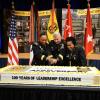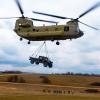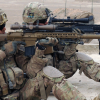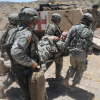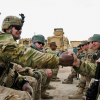AUSA’s Institute of Land Warfare (ILW) has recently released a new publication.“Strategic Readiness: The U.S. Army as a Global Force” (Defense Report 16-3, June 2016) discusses the global activities and demands facing the Army and the practical steps the Army is taking in the form of readiness exercises to meet these demands.Events in recent military history demonstrate the serious cost across multiple spheres that occurs in times of shortfalls and capability gaps. As the nature of operations over the past 25 years has forced the military to focus on particular theaters – in Operation Desert...
The Association of the U.S. Army (AUSA) is embarking on the AUSA Chapter Excellence Project. The project’s a goal is strengthening its chapters by reviewing the policies and resources that support local volunteer leaders.The project will identify what does and doesn’t work at the regional, state and chapter levels so that success can be shared more broadly across the entire Association. Project teams will review bylaws, operations manuals, leader training, information technology, communications, and programs for awards and incentives and will make recommendations for changes in AUSA policies.T...
Where do new Army officers come from? They come from the U.S. Military Academy at West Point, New York; Officer Candidate School; and, for a century now, the Reserve Officers’ Training Corps.The ROTC program was established by Congress, June 3, 1916. Today, after 100 years of providing officers to lead America’s Army, ROTC is responsible for providing some 70 percent of new lieutenants to the Regular Army, Army National Guard and Army Reserve – about 5,300 new officers each year in total to the Army. The ROTC program also produces officers for the Navy, Marine Corps and Air Force as well.Army...
The first woman in U.S. history to achieve the rank of four-star general said she learned her first leadership lesson as a newly minted second lieutenant: Never walk by a mistake.“I was taught that if you walk by a mistake, you’ve just set a new lower standard,” said retired Gen. Ann Dunwoody. She spoke at the General Bernard W. Rogers Strategic Issues Forum presented by AUSA’s Institute of Land Warfare.Dunwoody, a member of the Association’s Council of Trustees, said the first woman in U.S. history to achieve the rank of four-star general said she learned her first leadership lesson as a...
Joseph Lee “Joe” Galloway, noted war correspondent and co-author of the 1992 best-selling Vietnam War narrative “We Were Soldiers Once … and Young,” is the first civilian to be honored in The Army Historical Foundation’s (AHF) newly launched Registry of the Army Community, the civilian complement to the foundation’s web-based Registry of the American Soldier. Both registries, along with the new Registry of the Animals in Service to the Army, will eventually be enshrined in the National Museum of the United States Army. Individuals may add themselves or another to the registries by following...
Even as the U.S. military shrinks and global threats mount, the Army is going through a number of significant transitions that will present additional challenges in the years to come, said Gen. Robert B. “Abe” Abrams, commander of the U.S. Army Forces Command.On top of the list is the move to a new unit “sustainable readiness” model that’s “about being ready all the time,” Abrams said in the keynote address at AUSA’s recent Hot Topic forum on Army Force Projection and Sustainment. He added, “In the run-up to a mission, you’ve got to be ready. When you come home from a mission, it’s sustaining...
The U.S. Army has determined its highest priorities for training and developing future sustainment leaders for the expeditionary force of 2025 and beyond, said Maj. Gen. Darrell Williams, commanding general, U.S. Army Combined Arms Support Command (CASCOM) – Sustainment Center of Excellence and Fort Lee.Speaking during a panel discussion at the Association of the United States Army’s Hot Topic forum on Army force projection and sustainment, Williams discussed CASCOM’s sustainment competencies or sustainment pillars – “those things that we think all sustainment leaders of the future will...
Ask the U.S. Army Sniper School’s master trainer what it takes to be a great sniper, and he doesn’t immediately mention marksmanship.
“You have to be confident, committed, and cool under pressure,” said Sgt. 1st Class Matthew Fox.
On the forward edge of the battle space where snipers usually ply their trade, “you don’t have time to call back to headquarters. You have to make the decision on the spot.”
Each year, several hundred soldiers come to the Fort Benning, Ga., school from the infantry, cavalry scout and special operations communities. Training them to become snipers falls to the 18...
The Association of the U.S. Army wrapped up a successful LANPAC Symposium and Exposition on May 26, an event that had record attendance for meaty discussions on land forces in the Indo-Asia-Pacific Theater.More than 28 nations participated.“What a great week,” said Gen. Robert B. Brown, the U.S. Army Pacific commanding general. “It really went beyond expectations,” he added.More than 1,700 people attend the Honolulu event, a 40 percent increase over 2015 and significant jump from the just under 600 people who attended AUSA’s first LANPAC conference in 2013.A fifth LANPAC Symposium and...
Te Army is pursuing artillery, missile and rocket advances that could give long-range capabilities at a battalion level, and have shore-based, concealed systems with surface-to-surface, surface-to-air and surface-to-ship abilities, Army Lt. Gen. H.R. McMaster, Jr., said May 24 during a discussion of land force and maritime operations.Speaking at the Association of the U.S. Army’s LANPAC Symposium and Exposition in Honolulu, Hawaii., McMaster said such an Army land-based battery would have advantages over sea-based missiles by being prepositioned, and would present potential adversaries with...
The National Training Center, or NTC, and Fort Irwin conducted a ground breaking ceremony for a facility that will support a unit that operates Army unmanned aircraft systems, or UASs, Jan. 12.The complex will provide a headquarters for B Company, 229th Aviation Regiment, and house a fleet of 12 MQ-1C Gray Eagle unmanned aircraft. The unit known as the “Flying Tigers” has operated Gray Eagles since it was re-activated here Oct. 16, 2014. The unit is organized under the 2916th Aviation Battalion, 916th Support Brigade, and is deployed. After being reestablished, soldiers of B Company began...
Every soldier and leader knows that moral principles govern our behavior in war. In combat, we are responsible for attending to the difference between combatants and noncombatants, using proportional force even in the pursuit of legitimate targets and objectives, providing due care to the innocent even if doing so requires risk to ourselves, and assuring that we limit collateral damage as much as possible. Application in combat is part of our tactical competence.
But what about the moral dimension of strategic competence? This dimension is clearest at that intersection of a proper understanding...
The Navy admiral who commands the U.S. Pacific Command said the U.S. Army and its land-force partners from around the Indo-Asian-Pacific Theater are a key part of the region’s security environment. Speaking May 25 at the LANPAC Symposium and Exposition of the Association of the U.S. Army’s Institute of Land Warfare, Adm. Harry B. Harris Jr. said he believes the Army must project power into the other domains. “The core mission of the Army is to fight and win in the land domain, and you are good at it,” Harris said. Adding, “But the Army can project power in other domains.” A key example, he...
Thirty-eight training days a year is “insufficient” for reserve component units with crucial skills needed early in a fight, the commanding general of the 9th Mission Support Command said May 25. The discussion came during the second day of the LANPAC Symposium and Exposition, an event hosted by the Association of the U.S. Army’s Institute of Land Warfare.Brig. Gen. Stephen K. Curda, who has headed the Army Reserve unit since last July, said if money can be found, more training would aid Army National Guard and Army Reserve units. “Although funding is always a challenge, I like to think the...
If you happen to be a professional academic, a stoic or just generally cantankerous, please promise you won’t stop reading after the next sentence.
This article is about humor as an element of Army leadership.
That’s right, humor. It’s a uniquely human quality that increases resilience, creativity and trust while decreasing stress, fear and power distance—attributes that are arguably the very antithesis of toxic leadership. Despite these well-documented benefits coupled with the seemingly ubiquitous senior leader guidance that having fun or a sense of humor ranks among the most important aspects...



